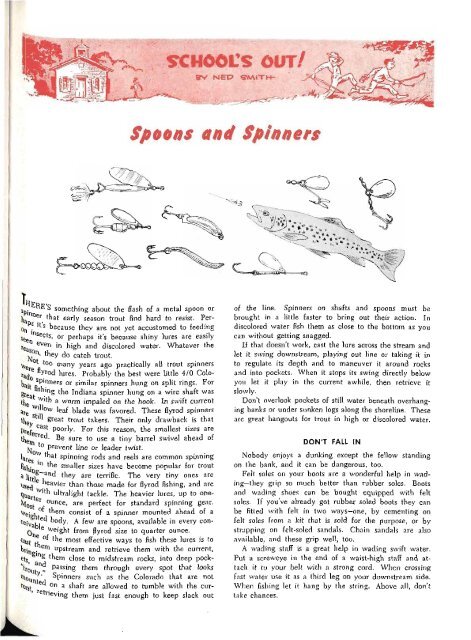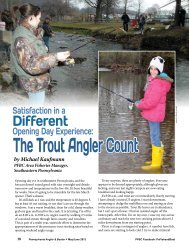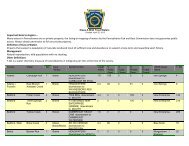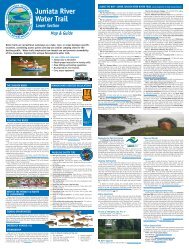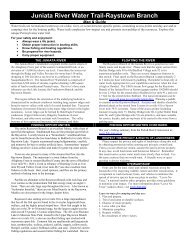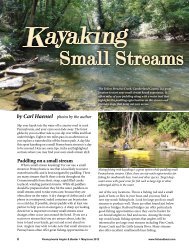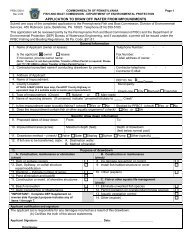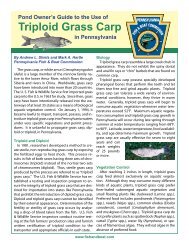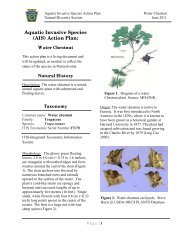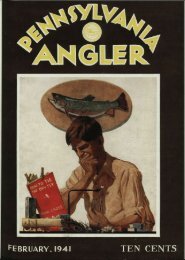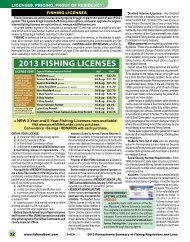m&M: - Pennsylvania Fish and Boat Commission
m&M: - Pennsylvania Fish and Boat Commission
m&M: - Pennsylvania Fish and Boat Commission
You also want an ePaper? Increase the reach of your titles
YUMPU automatically turns print PDFs into web optimized ePapers that Google loves.
sjy ^ something about the flash of a metal spoon or<br />
ha ner , ^ at ear ^ v season trout find hard to resist. Per-<br />
0 . lts because they are not yet accustomed to feeding<br />
See lnSects ' or perhaps it's because shiny lures are easily<br />
te<br />
eve n in high <strong>and</strong> discolored water. Whatever the<br />
^° n > they do catch trout.<br />
° too many years ago practically all trout spinners<br />
faj 6 fl> ! r ° d lures - Probabl y the best were little 4/0 Coloba.<br />
s Pinners or similar spinners hung on split rings. For<br />
or<br />
s «ing the Indiana spinner hung on a wire shaft was<br />
wit<br />
h a worm impaled on the hook. In swift current<br />
^illov are -•!!° W ' ea ^ D ' a de was favored. These flyrod spinners<br />
the great trout talc ers. Their only drawback is that<br />
Pref ° ast Poorly- For this reason, the smallest sizes are<br />
tho-. rred- "em<br />
Be sure to use a tiny barrel swivel ahead of<br />
to<br />
Prevent line or leader twist.<br />
\'<br />
Ve • spinning rods <strong>and</strong> reels are common spinning<br />
fishj m t ' le sma " er sizes have become popular for trout<br />
a ]jtt.i S ^ ana - they are terrific. The very tiny ones are<br />
Hsecl 6 eavier than those made for flyrod fishing, <strong>and</strong> are<br />
qUa wit h ultralight tackle. The heavier lures, up to one-<br />
Kf0 er ounce, are perfect for st<strong>and</strong>ard spinning gear.<br />
W6j i them consist of a spinner mounted ahead of a<br />
° e 'V ki Doa ^ v - A few are spoons, available in every con-<br />
Q e weight from flyrod size to quarter ounce.<br />
Cas( , °t the most effective ways to fish these lures is to<br />
b.tjn . ein upstream <strong>and</strong> retrieve them with the current,<br />
e<br />
ts ^ them close to midstream rocks, into deep pock-<br />
"trou a „ P a ssing them through every spot that looks<br />
tn0u Spinners such as the Colorado that are not<br />
V Q on a s^t are allowed to tumble with the cur-<br />
' Grieving them just fast enough to keep slack out<br />
*%'«<br />
Spoons <strong>and</strong> Spinners<br />
of the line. Spinners on shafts <strong>and</strong> spoons must be<br />
brought in a little faster to bring out their action. In<br />
discolored water fish them as close to the bottom as you<br />
can without getting snagged.<br />
If that doesn't work, cast the lure across the stream <strong>and</strong><br />
let it swing downstream, playing out line or taking it in<br />
to regulate its depth <strong>and</strong> to maneuver it around rocks<br />
<strong>and</strong> into pockets. When it stops its swing directly below<br />
you let it play in the current awhile, then retrieve it<br />
slowly.<br />
Don't overlook pockets of still water beneath overhanging<br />
banks or under sunken logs along the shoreline. These<br />
are great hangouts for trout in high or discolored water.<br />
DON'T FALL IN<br />
Nobody enjoys a dunking except the fellow st<strong>and</strong>ing<br />
on the bank, <strong>and</strong> it can be dangerous, too.<br />
Felt soles on your boots are a wonderful help in wading—they<br />
grip so much better than rubber soles. Boots<br />
<strong>and</strong> wading shoes can be bought equipped with felt<br />
soles. If you've already got rubber soled boots they can<br />
be fitted with felt in two ways—one, by cementing on<br />
felt soles from a kit that is sold for the purpose, or by<br />
strapping on felt-soled s<strong>and</strong>als. Chain s<strong>and</strong>als are also<br />
available, <strong>and</strong> these grip well, too.<br />
A wading staff is a great help in wading swift water.<br />
Put a screweye in the end of a waist-high staff <strong>and</strong> attach<br />
it to your belt with a strong cord. When crossing<br />
fast water use it as a third leg on your downstream side.<br />
When fishing let it hang by the string. Above all, don't<br />
take chances.


